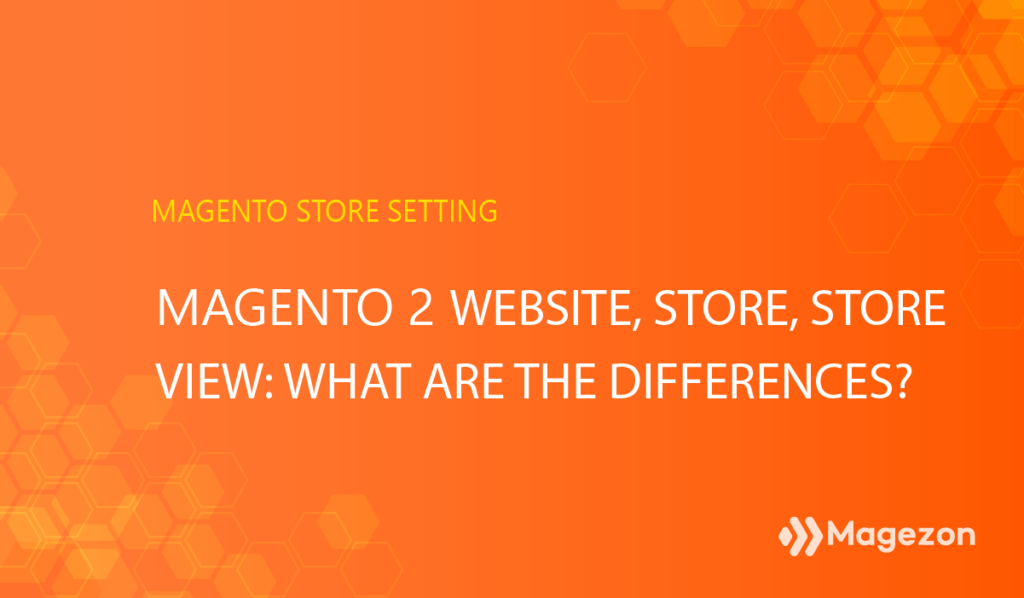
In this blog, we will explore what are Magento 2 website, store, store view along with their advantages and key features. Afterward, it’s necessary to know how to create them from the admin panel. No more further ado, let’s dive straight into it!
Table of contents
What are Magento 2 Website, Store, Store View?
Firstly, let’s get to know the Magento hierarchy. The Magento hierarchy includes four levels: global, website, store, and store view. These levels own the one-to-many parent/child relationships. Consequently if you look at the Magento hierarchy map, you will find it looks like a pyramid:
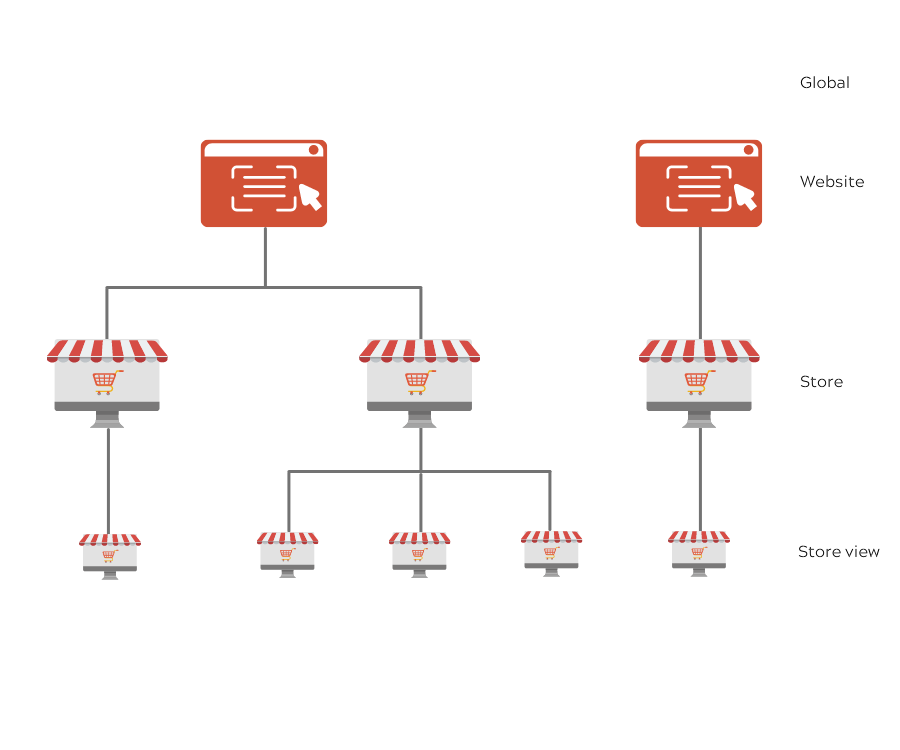
So under a global can be various websites. Under a website can be various stores. And under a store can be various store views.
It may be complicated at first for you. But don’t worry, we’ll go through each definition clearly and comprehensively right below. So stay tuned and keep reading!
1. Magento Global
Magento global is the highest level in the Magento hierarchy. In other words, each Magento hierarchy solely consists of one global view. While the other levels of Magento hierarchy allow you to multiply them, the global level does not.
Everything you do to the global scope will affect the settings of the whole pyramid. Typically, the global level allows you to configure the default value of your store includes:
- Configuring the stock settings.
- Setting a price for the same products of all stores.
- And collecting all customer bases from different websites into a big database.
| Keep reading to take a firm grasp of Magento Store Settings: How to Create Store Views in Magento 2 How to Change Magento 2 Default Store View How to Disable 2FA in Magento 2.4 Using Command Lines |
2. Magento Website

Magento website | Magento 2 website store store view
By default, the system provides you with only one website called the main website after installing Magento. However, you can create as many websites as your preference. Why do people need multiple websites? Well, it’s useful for those who sell various product types. For example, a store owner may run his business in the fashion and cosmetic industries. So he will create two separate Magento websites with different IP addresses and domain names which are fashion.com and cosmetic.com.
Users can set up various websites with completely different layouts, design, customer portfolio, website process, and many other aspects from the admin panel.
Besides, no matter how many websites you created, all settings will be configured and managed from one admin dashboard. That’s the undeniable advantage of launching a Magento-based store.
Below are the traits of the website level:
- Signify the source that hosts multiple stores. That is to say, the data of all stores will be gathered in their one parent website database.
- Each website has its unique customer and order base. These data can be interchangeable among them. For example, one can share customer accounts with others. Also, you can collect them into big data for the global level.
- Apply basic business logic, which are:
- Product prices
- Tax classes
- Currency
- Payment options
- Shipping options
- A website can manage its separate inventory.
- A website can manage its separate shopping cart.
3. Magento Store
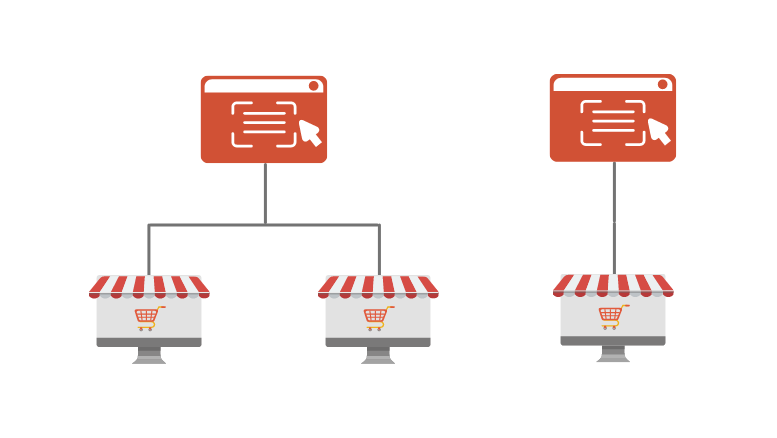
Magento store | Magento 2 website store store view
We go back to the example of creating multiple websites. One of the two industries you are selling is fashion which includes men’s and women’s clothes. Consequently, it’s possible to create two separate stores for each product type under the same website domain. You will be able to control products from a single admin panel.
Magento allows users to create and manage multiple stores for a website. So, a store is a child of a website. Creating multiple stores better the product and category management, especially for those who sell various product types.
Here are the traits of the store level:
- Multi-stores can share the same or different web domains. If two stores are under two separate websites, they will have different web domains and vice versa.
- By creating multiple stores, you can sell different categories of goods and services under the same domain name. Moreover, you can take complete control of these products within one single admin panel.
- You have the option to create a separate catalog for each store. Also, all stores of a website can share the same catalog.
- You can configure multiple languages and currencies at the store level.
- Creating multi-stores for different product types helps you improve the customer shopping experience. That is to say, they will find it easier to navigate to the section/products they are looking for.
- A store will reflect a real shop with all offered products and services well described.
- Include such attributes as checkout, checkin, selective pricing, and add-to-cart options.
Along with the out-of-the-box functionalities above, the store level still limits you from:
- Setting payment and shipping methods for each store.
- Changing the tax structures within multiple stores.
- Managing separate inventory for each store.
- Managing any configuration settings between Magento multiple stores.
4. Magento Store View
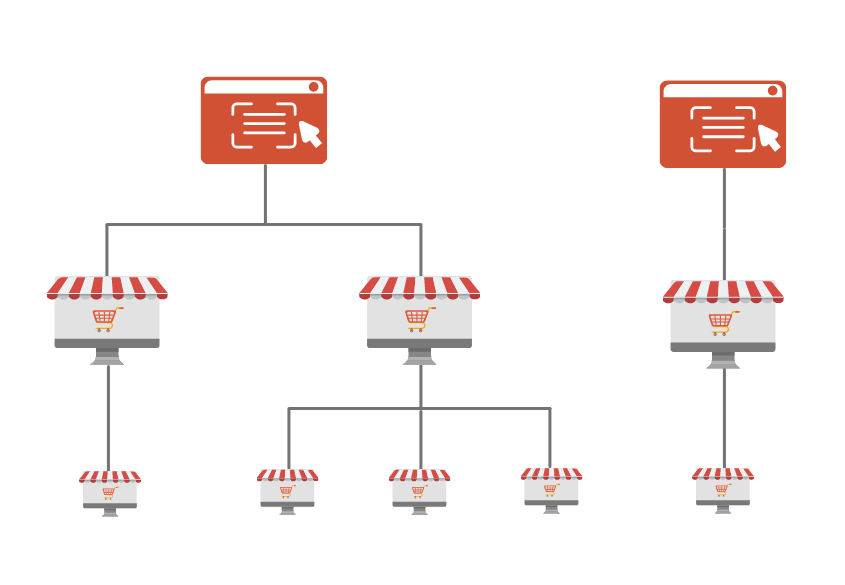
Magento store view| Magento 2 website store store view
To better explain a Magento store view, we’ll continue with the example of a website selling women’s and men’s clothes. In the women’s clothing store, the brand wants to sell products in the global market. As a result, to localize the store with a defined set of customers, it will create multiple store views under a store. Each store view displays a different language for the local visitors.
Typically, there is only one default store view when you’ve just installed Magento. You can add more other store views to meet the multi-language store requirements or for other purposes. So, from the front end, customers can switch from one store view to others by the language selector located in the header of your page.
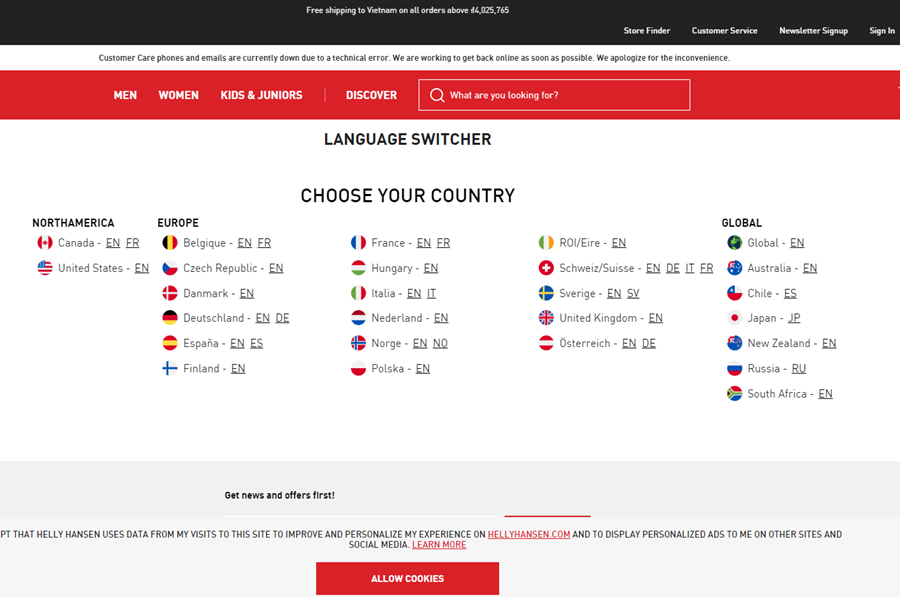
We can tell a range of benefits that the store view level offers:
- Enhance customer shopping experience by switching your store content to their mother tongue and change the prices into their local currencies.
Read more: How to set up multi-currency in Magento 2
- On the one hand, it’s suitable for multinational online stores which sell products across borders. On the other hand, businesses can also make the most out of this feature to quickly apply different store themes and unique designs.
- The store view level supports localization for users as it considers the language and the location of customers.
- The store views under the same store share the same category structure, payment method, and shipping method.
Magento 2 Store Switcher
Note: Magento 2 Store Switcher allows you to display the appropriate store views to local communities by detecting their locations from their IP addresses. Consequently, customers will have a bold and unique shopping experience as they can access the correct language, currency, and other localized factors. Below are the fantastic features of the extension:
- Determine website visitor’s location using IP address
- Automatically switch to the appropriate store view
- Manage multiple profiles in a breeze using a grid
Sum up
Look at the table below to have a quick overview of the Magento website, store, store view.
Magento website, store, store view
| Website | Store | Store view | |
| Level | The second level of the Magento hierarchy, under the global level. | The third level of the Magento hierarchy, under the website level. | The lowest level of the Magento hierarchy, under the store level. |
| Features | – Two websites can have the same or different domains. – Different websites have different settings. – Two websites can share their customer and order bases. – A website can create multiple stores. The minimum number of stores under a website is one. – A website can have separate layouts, design, customer portfolio, website process, and many other aspects. | We have 2 cases: Case 1: If two stores are under different websites, they will own separate settings. Case 2: If two stores are under the same website: – Have the same domain and IP address. – Share the same customer base, shopping cart, and checkout process. – Share the same payment method, shipping method, and tax. – Besides, multiple stores can get different category structures (root categories). | If two store views are children of a store, they will have: – The same settings – Have different theme Multiple languages and currencies – Have separate settings for displaying repeated sections like text, template, label,… |

Optimize Your Magento Store With Powerful Extensions
Looking for fast, efficient and well-coded extensions to build or optimize your Magento stores for sales boosting? Then visit Magezon website and grab necessary add-ons for yours today!
 Magezon Blog Help Merchants Build Comprehensive eCommerce Websites
Magezon Blog Help Merchants Build Comprehensive eCommerce Websites

